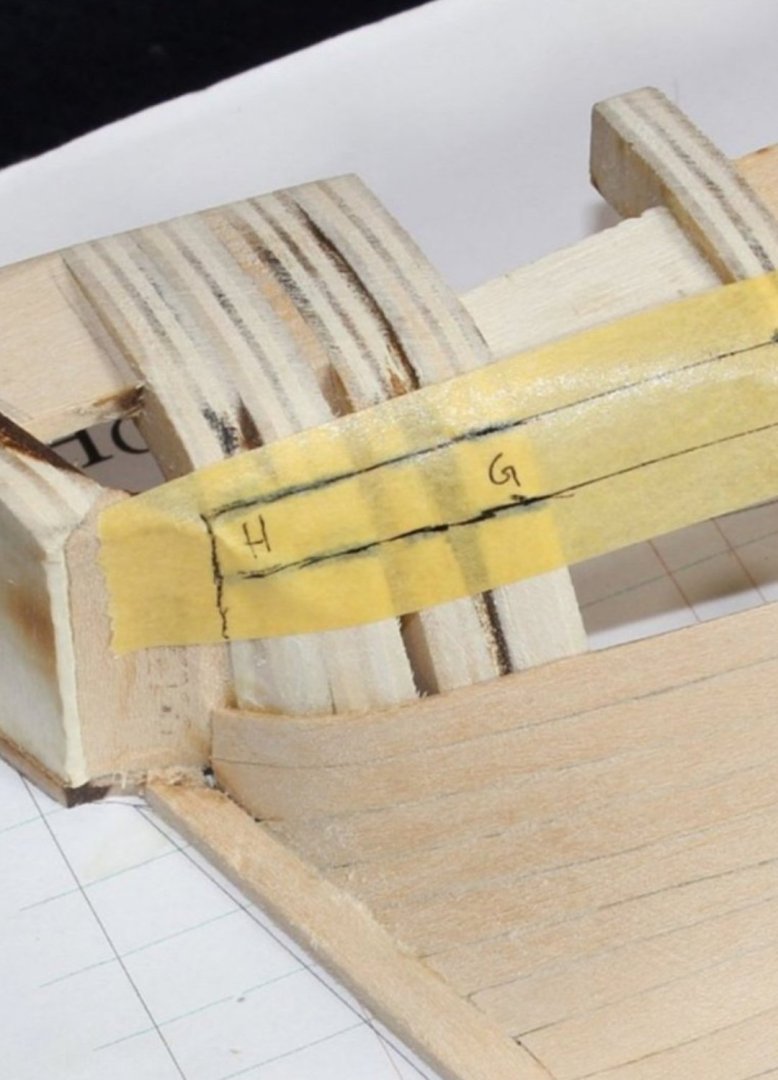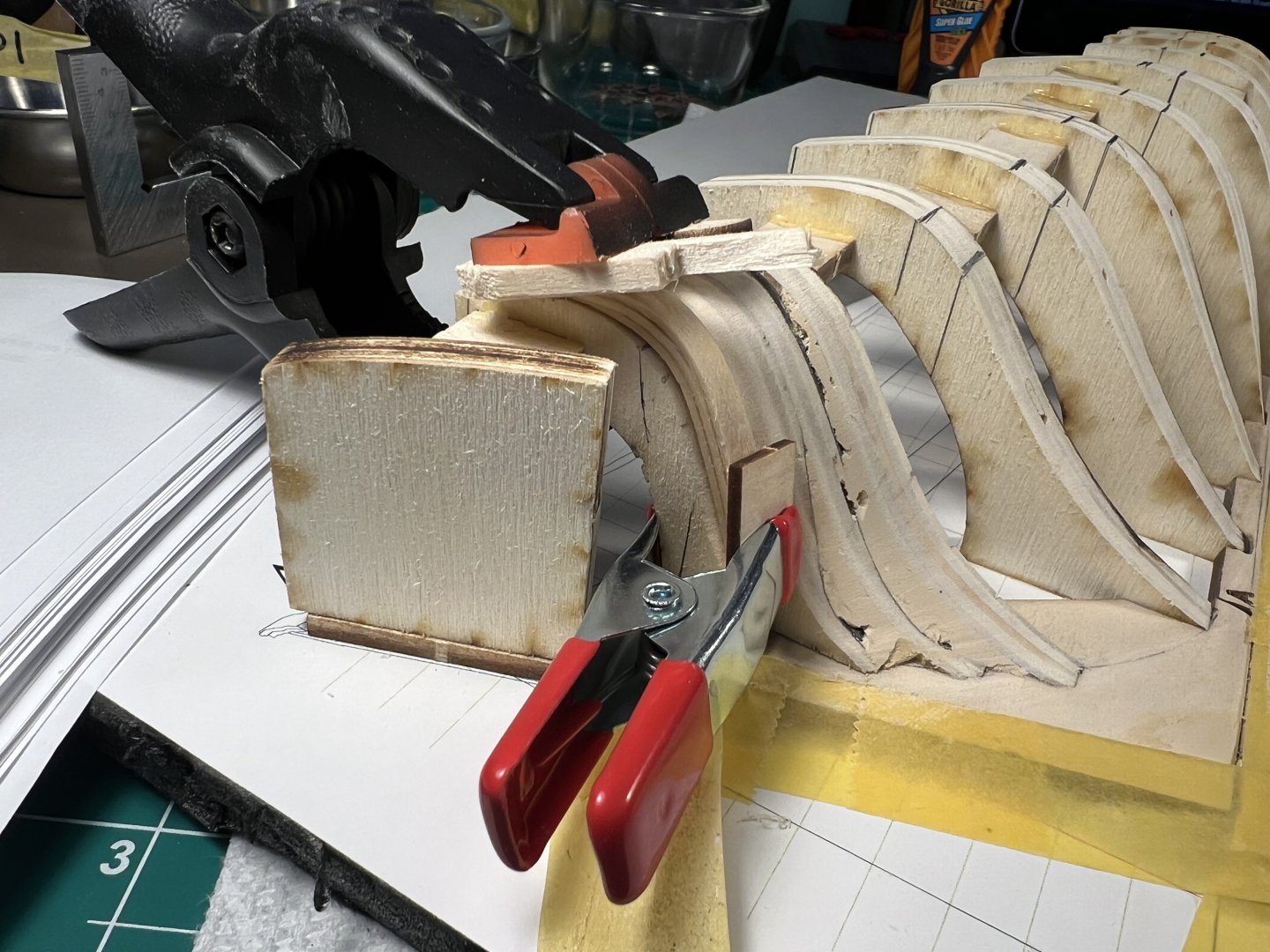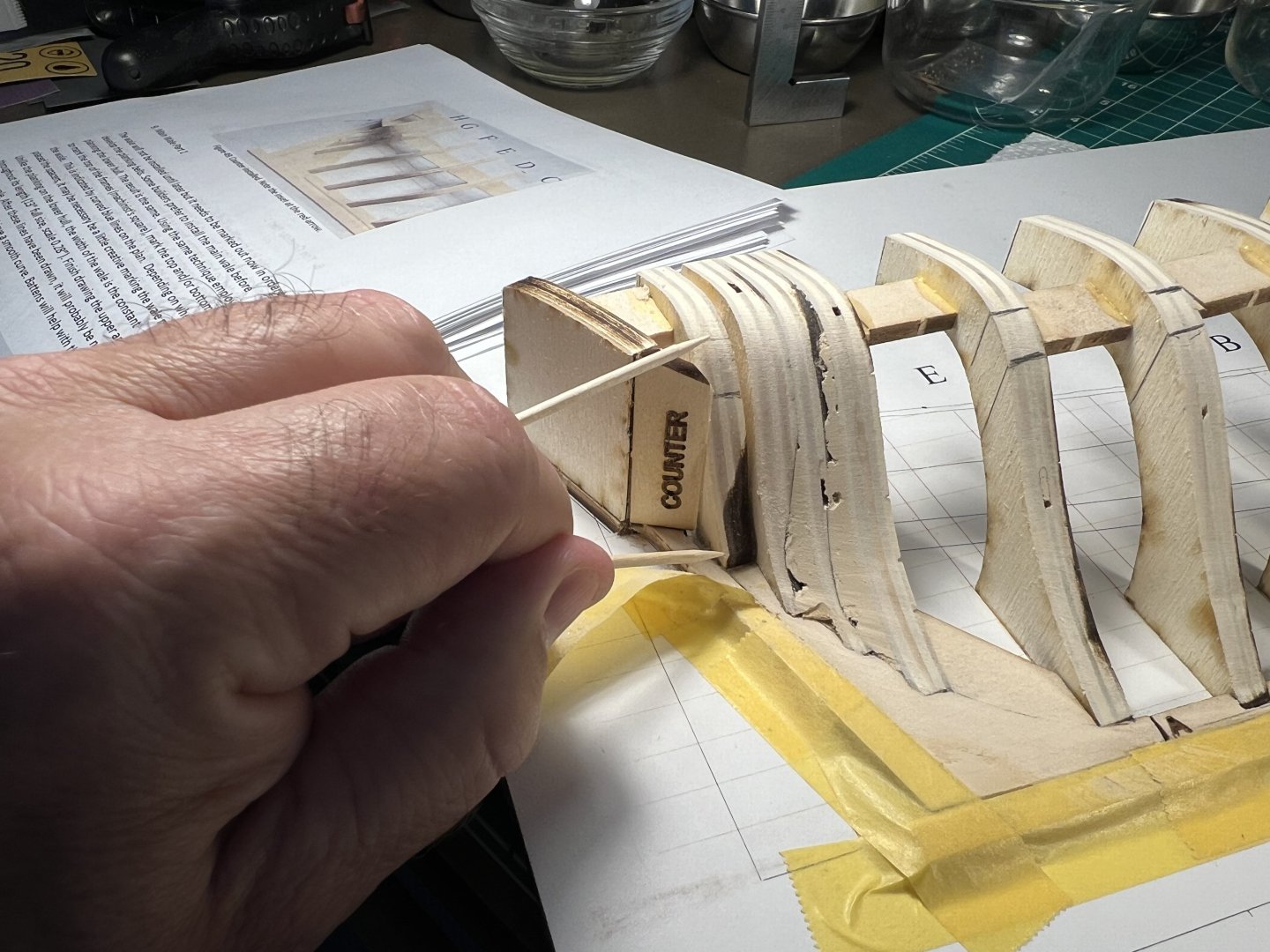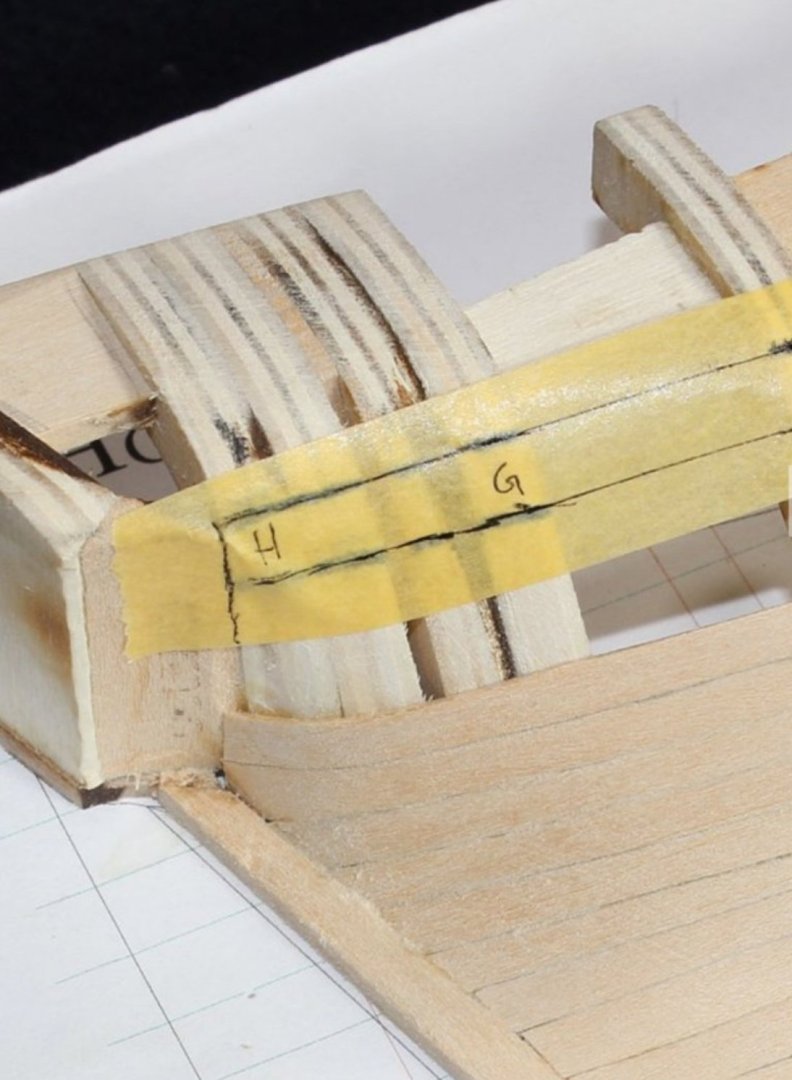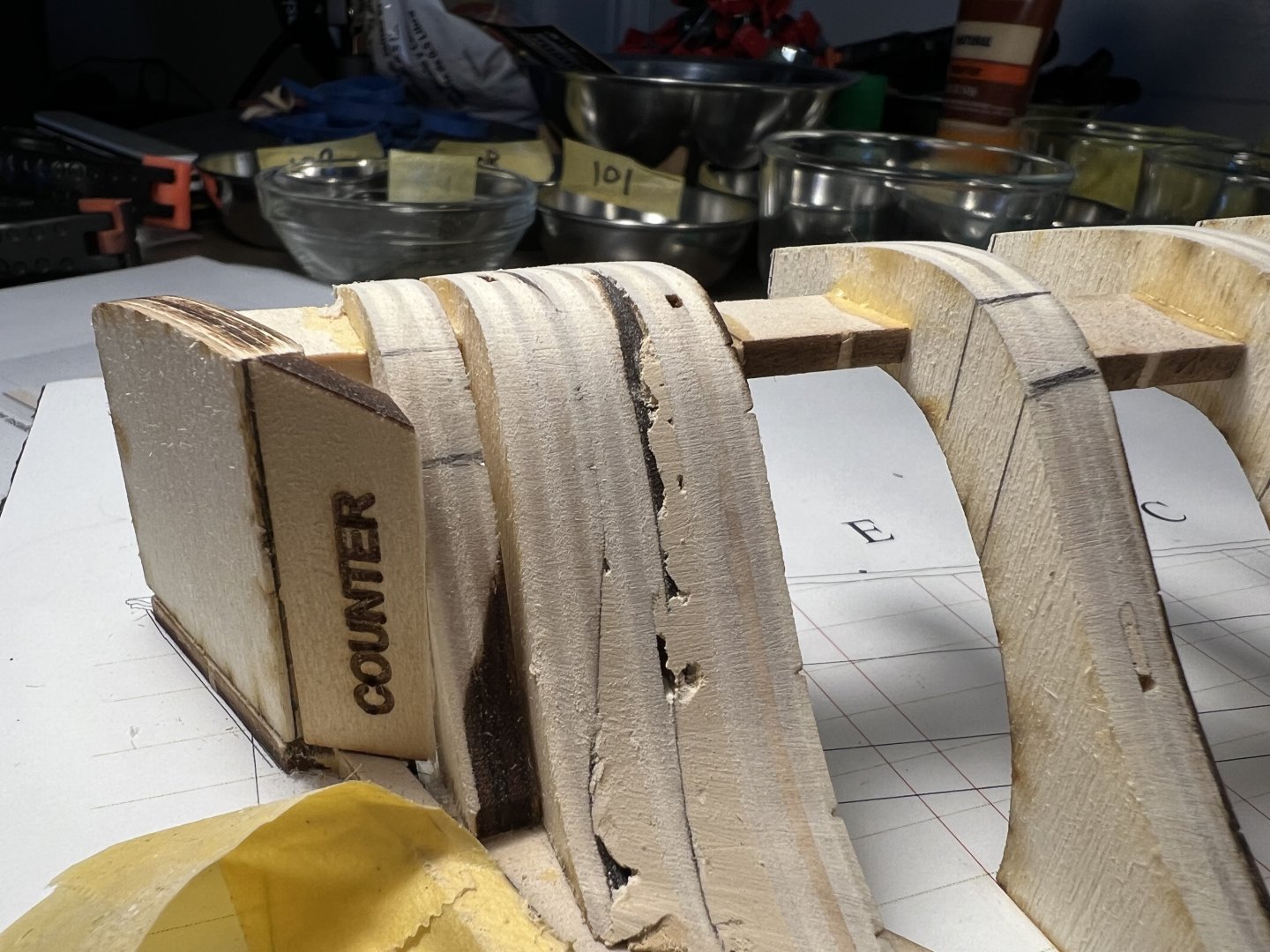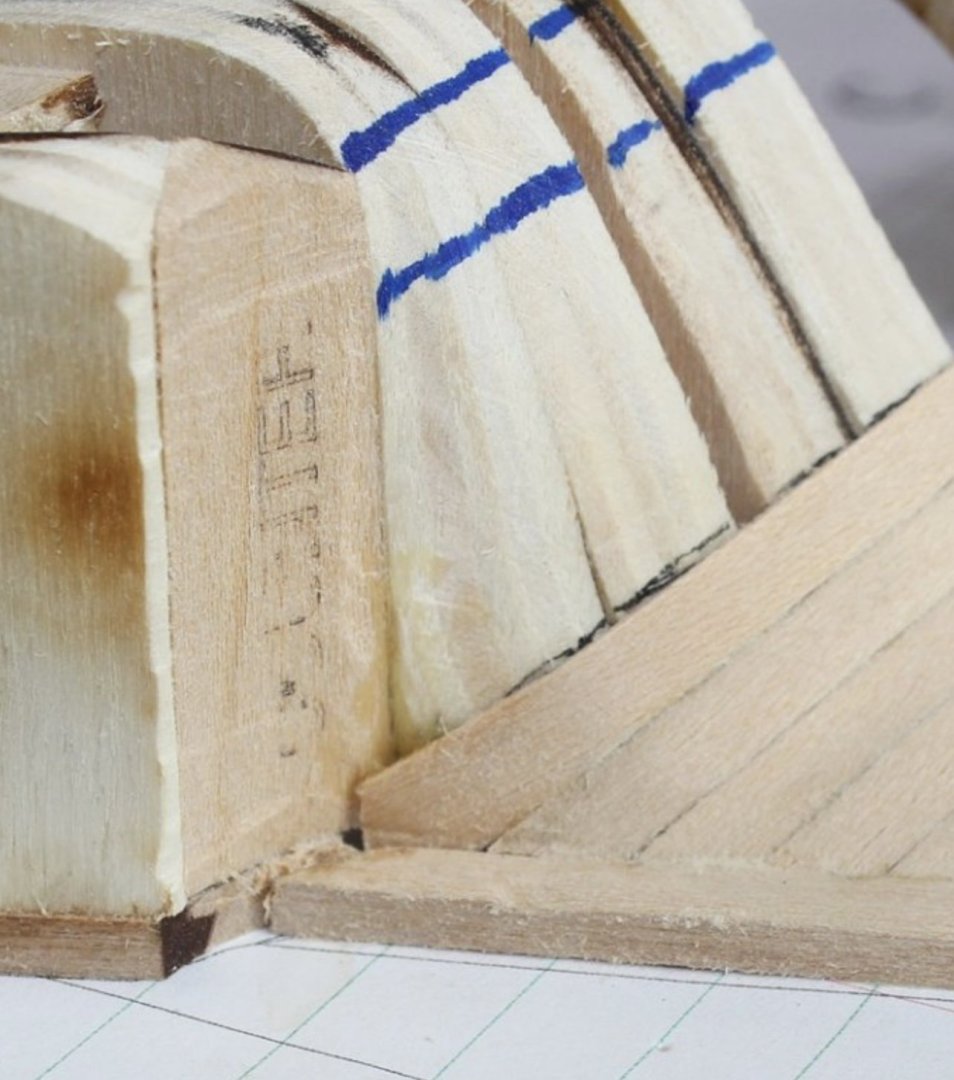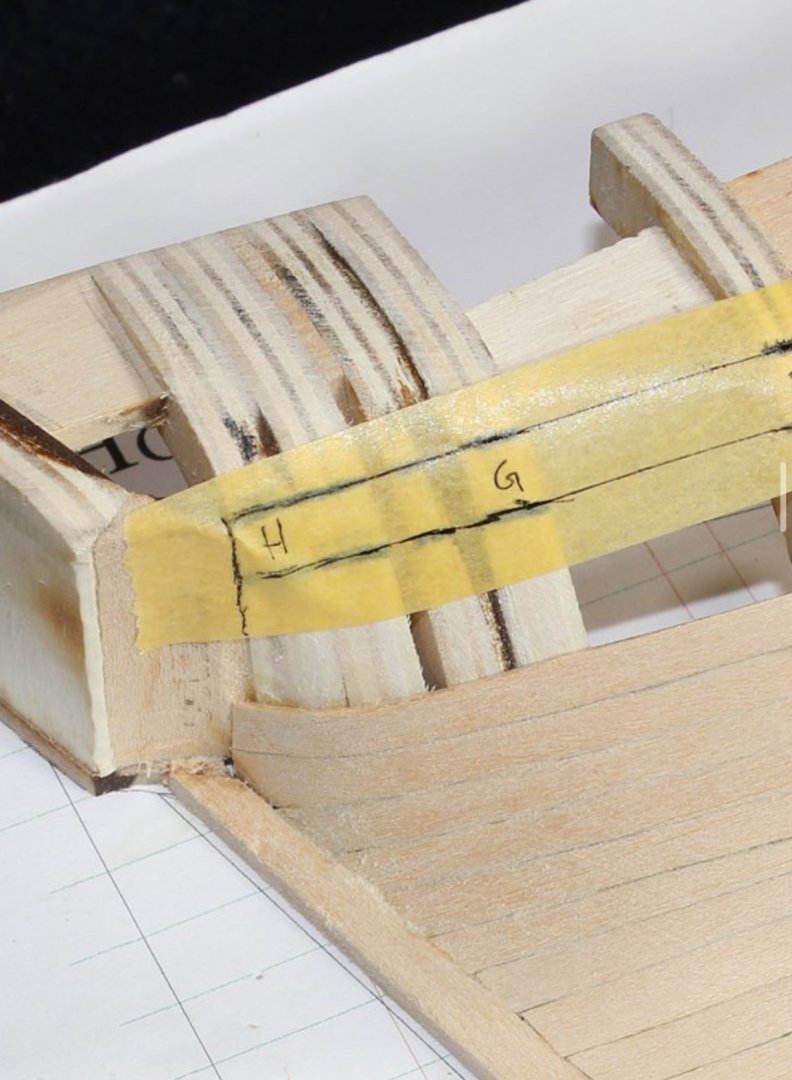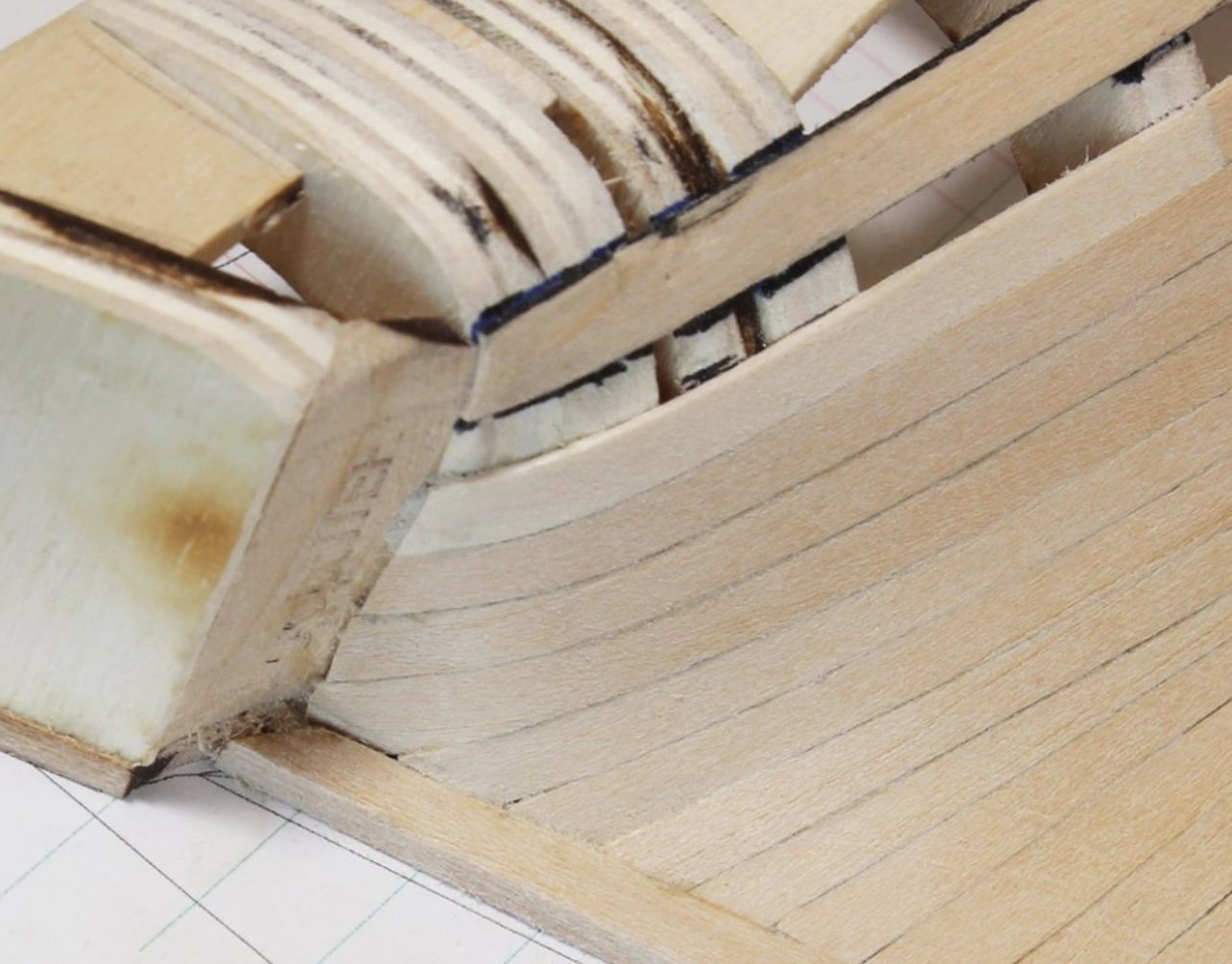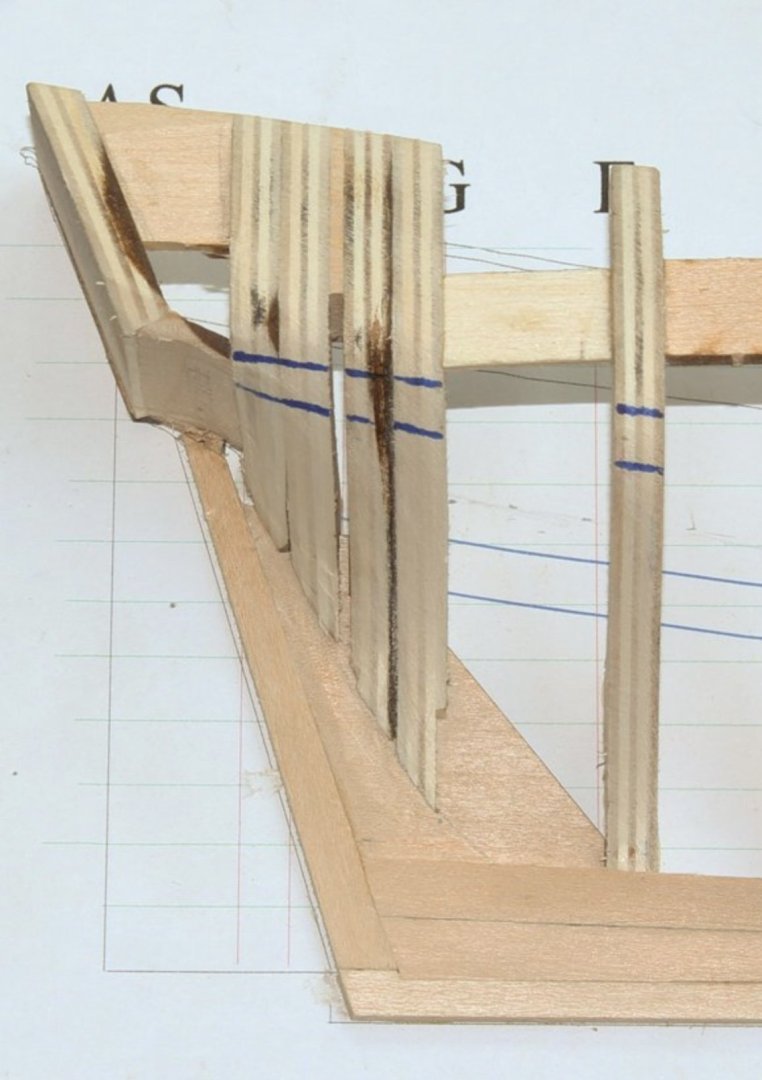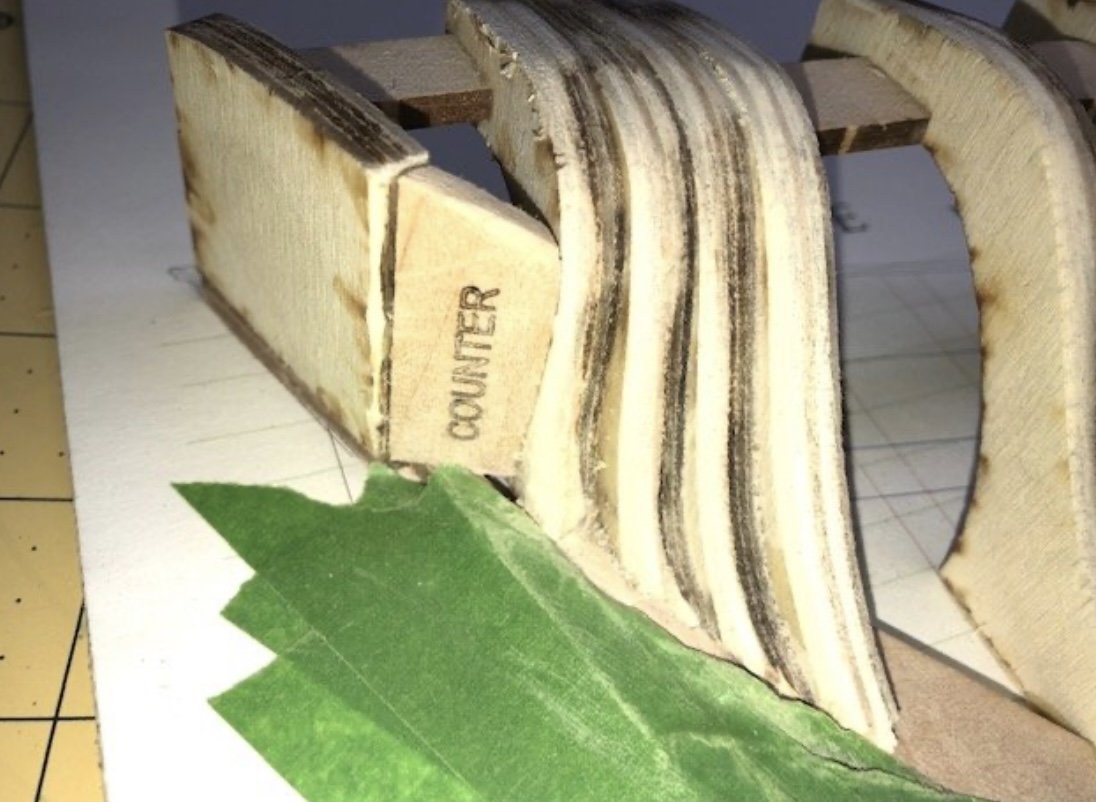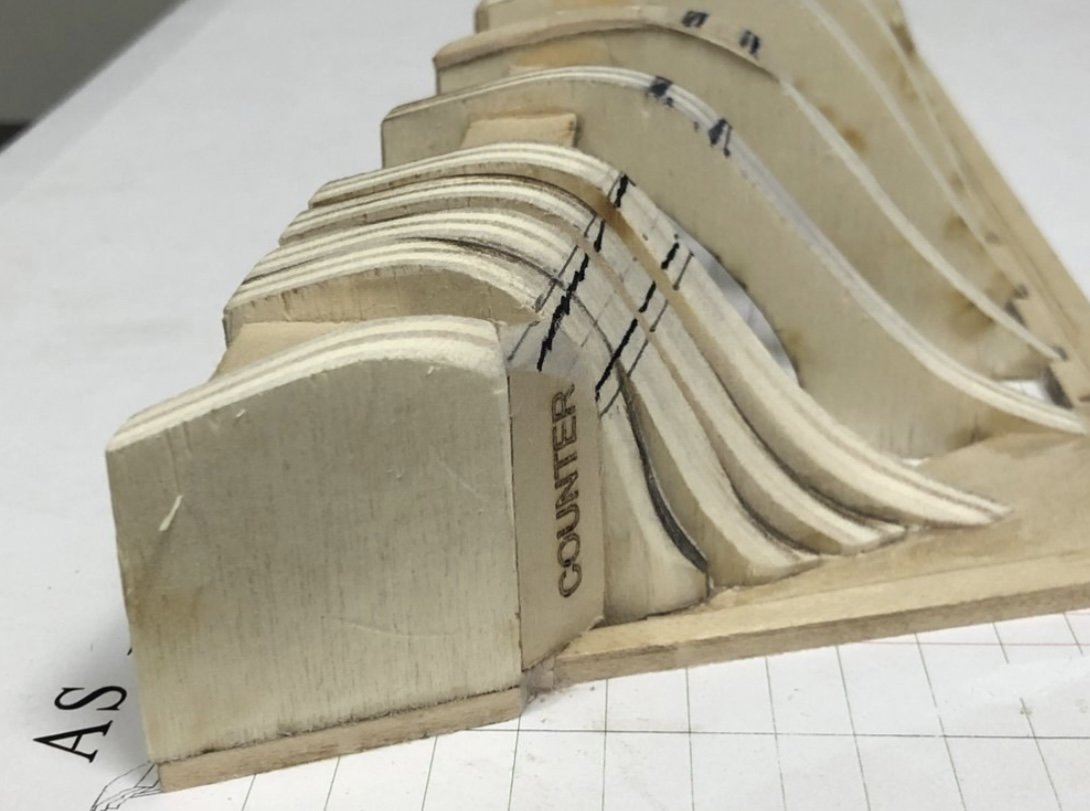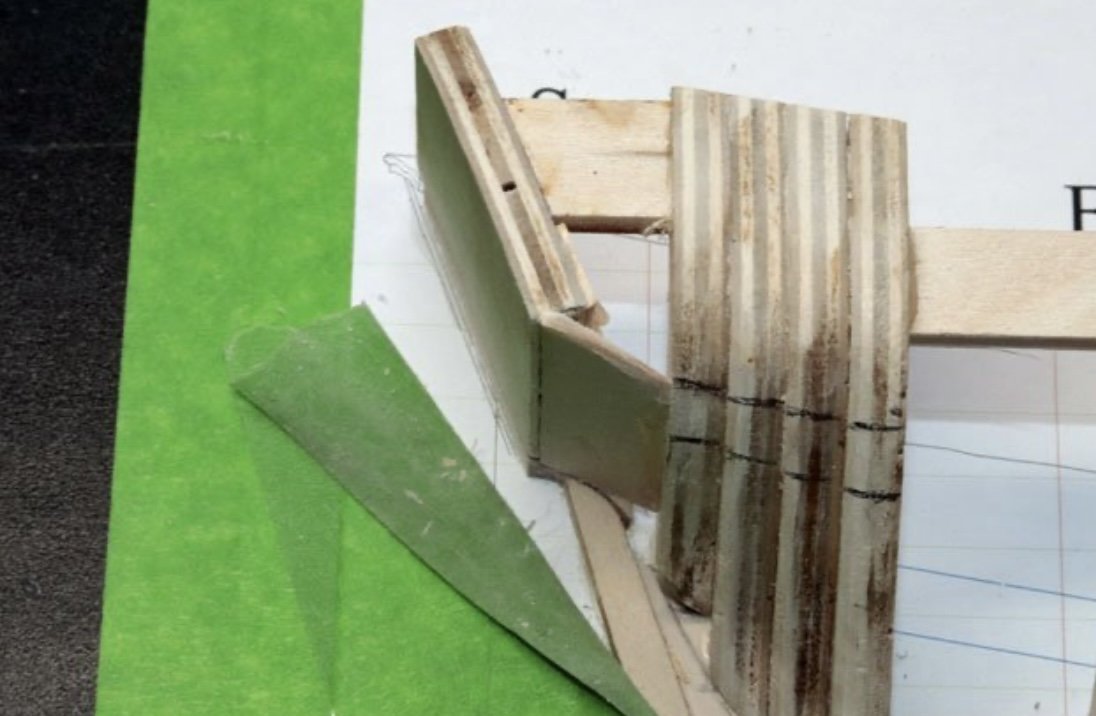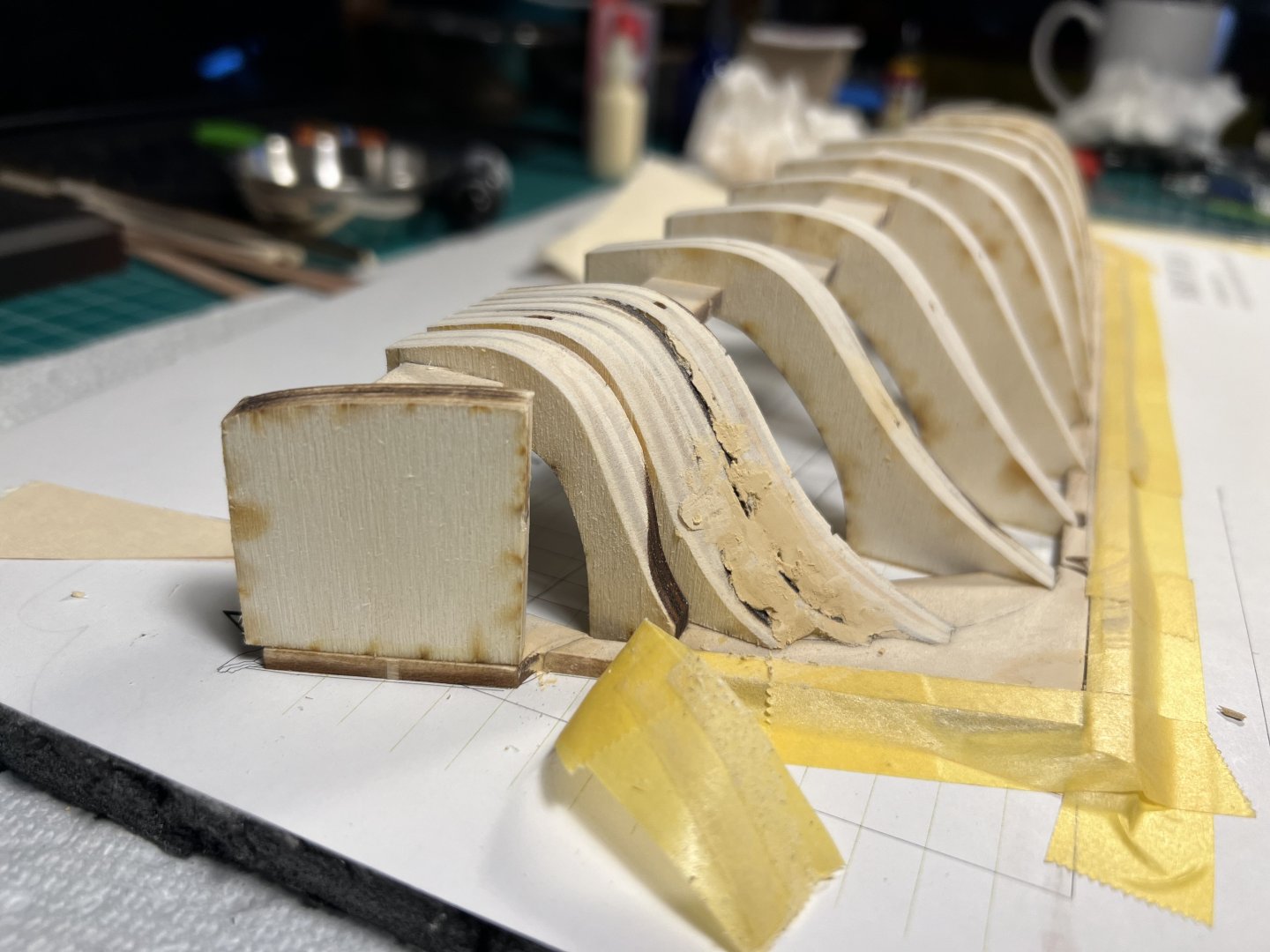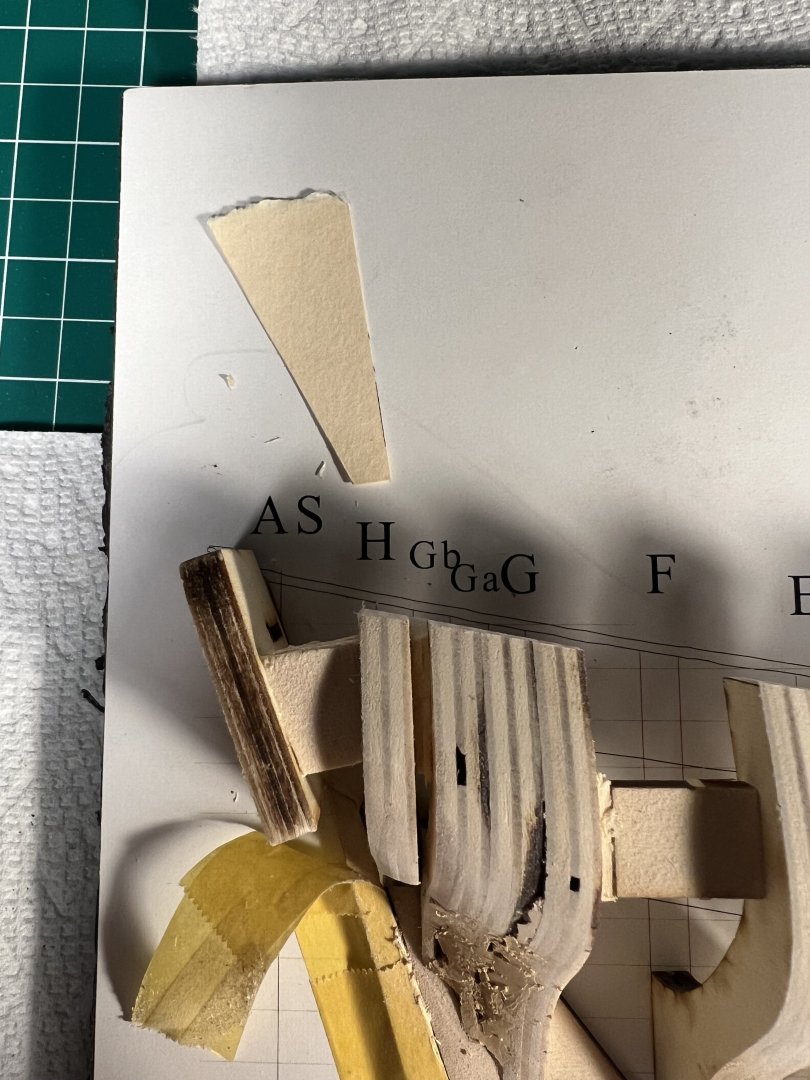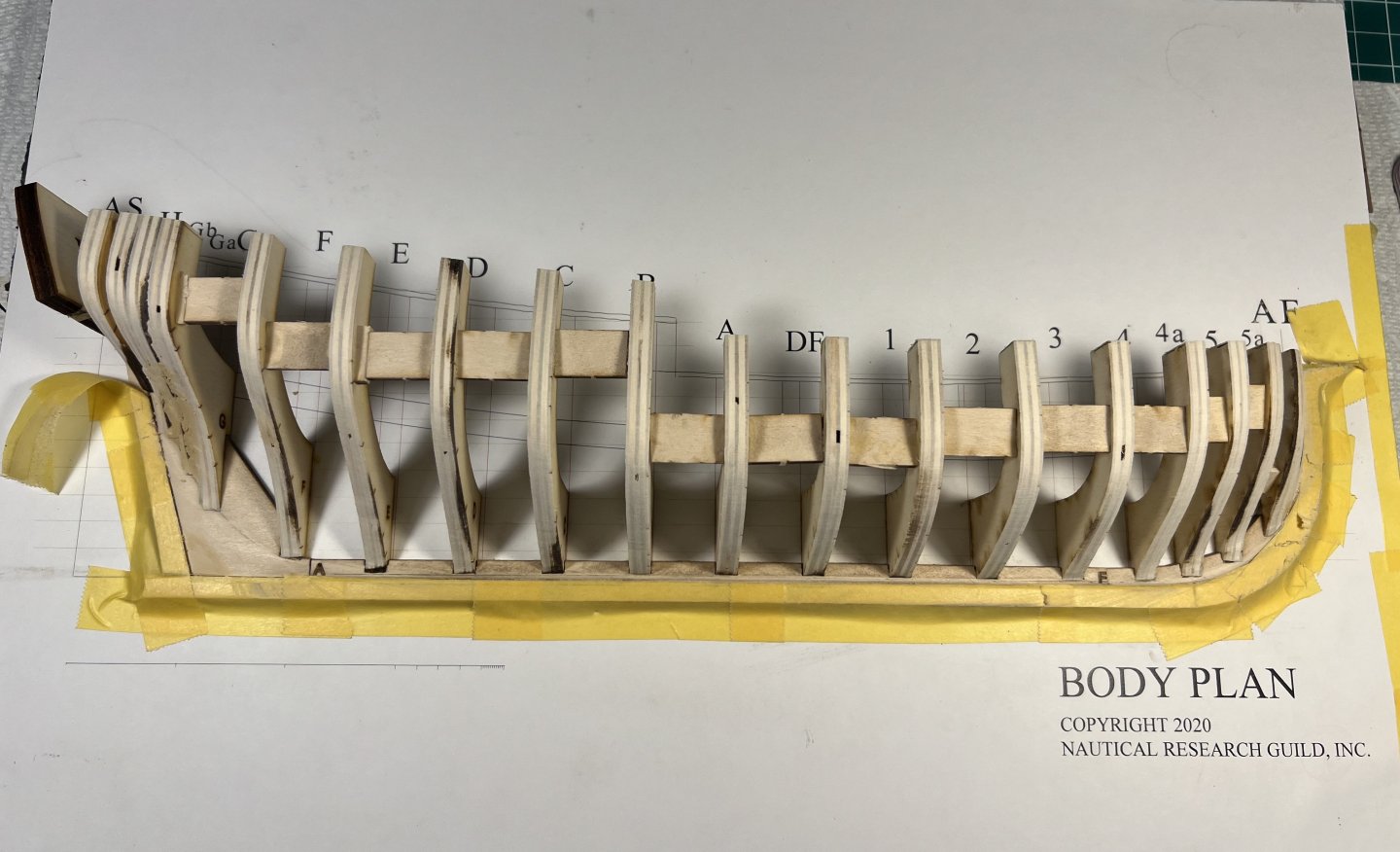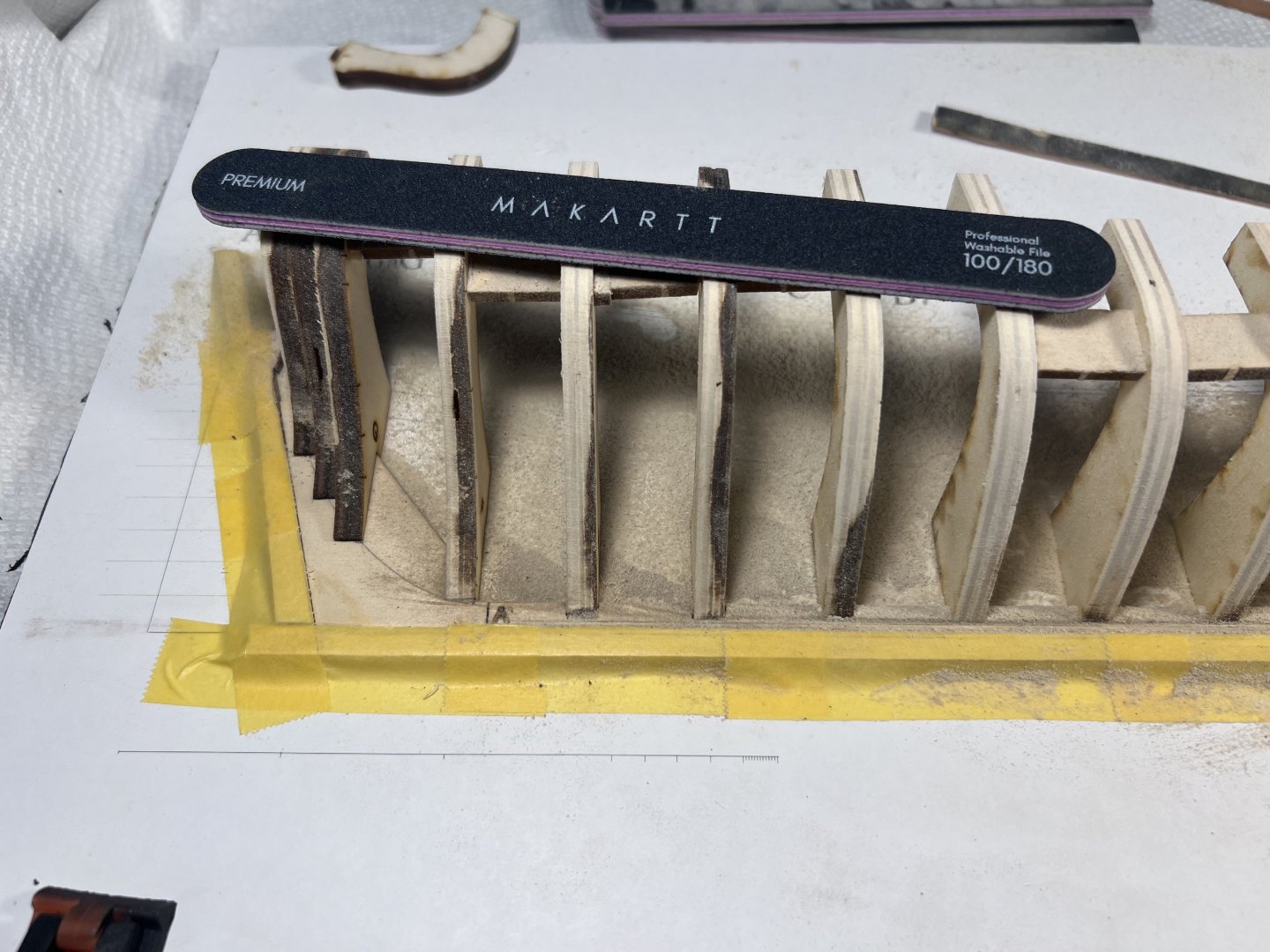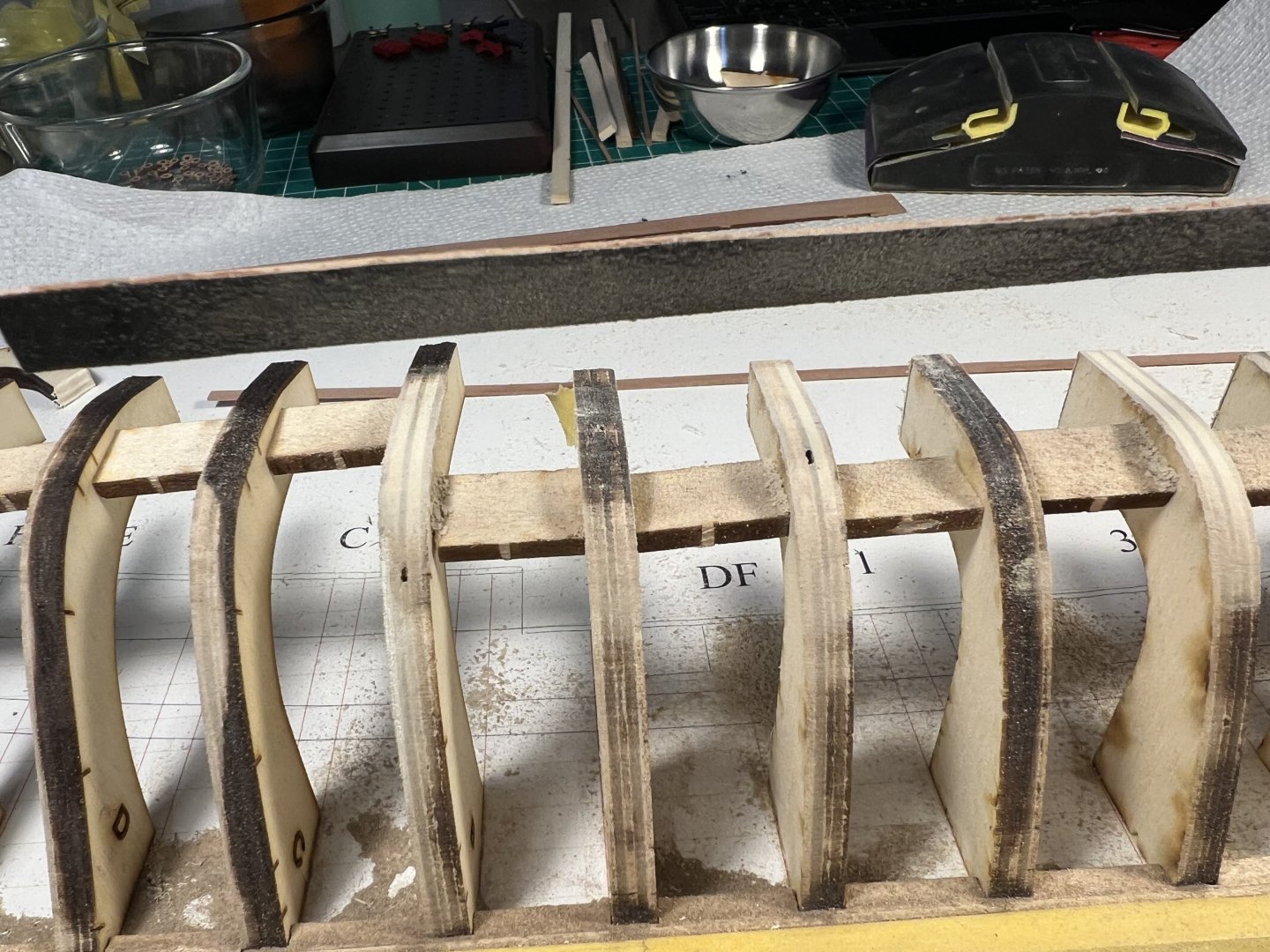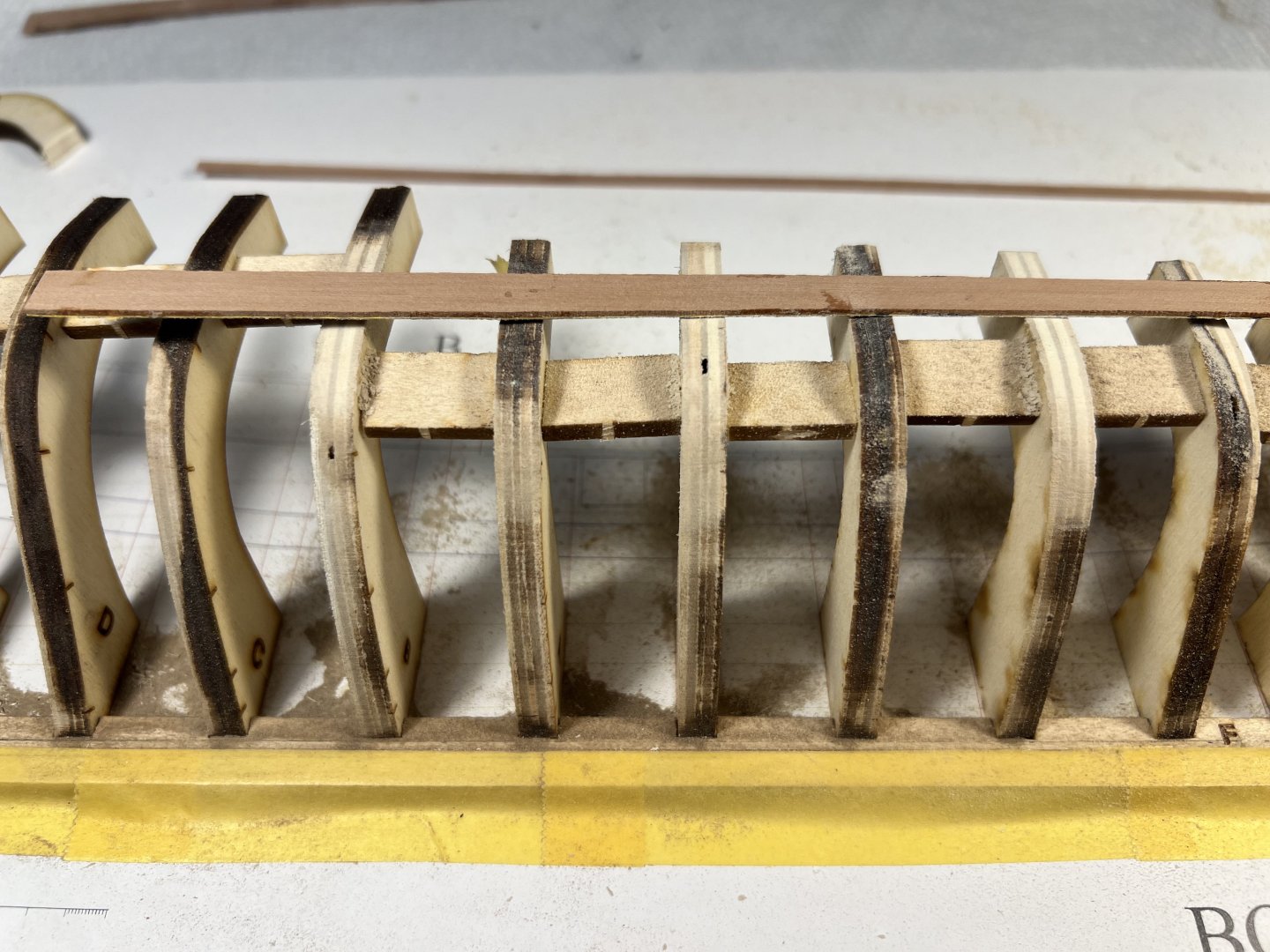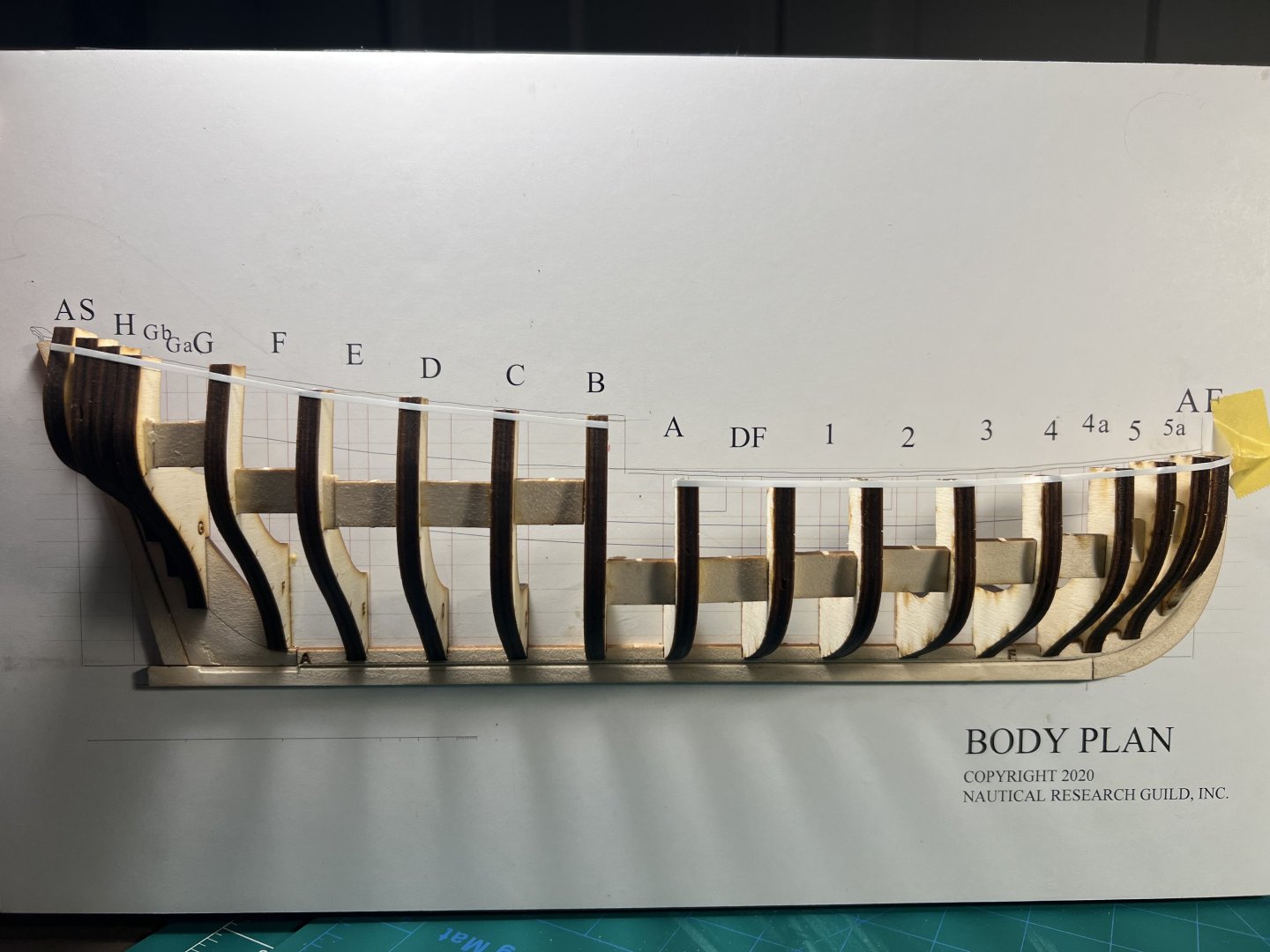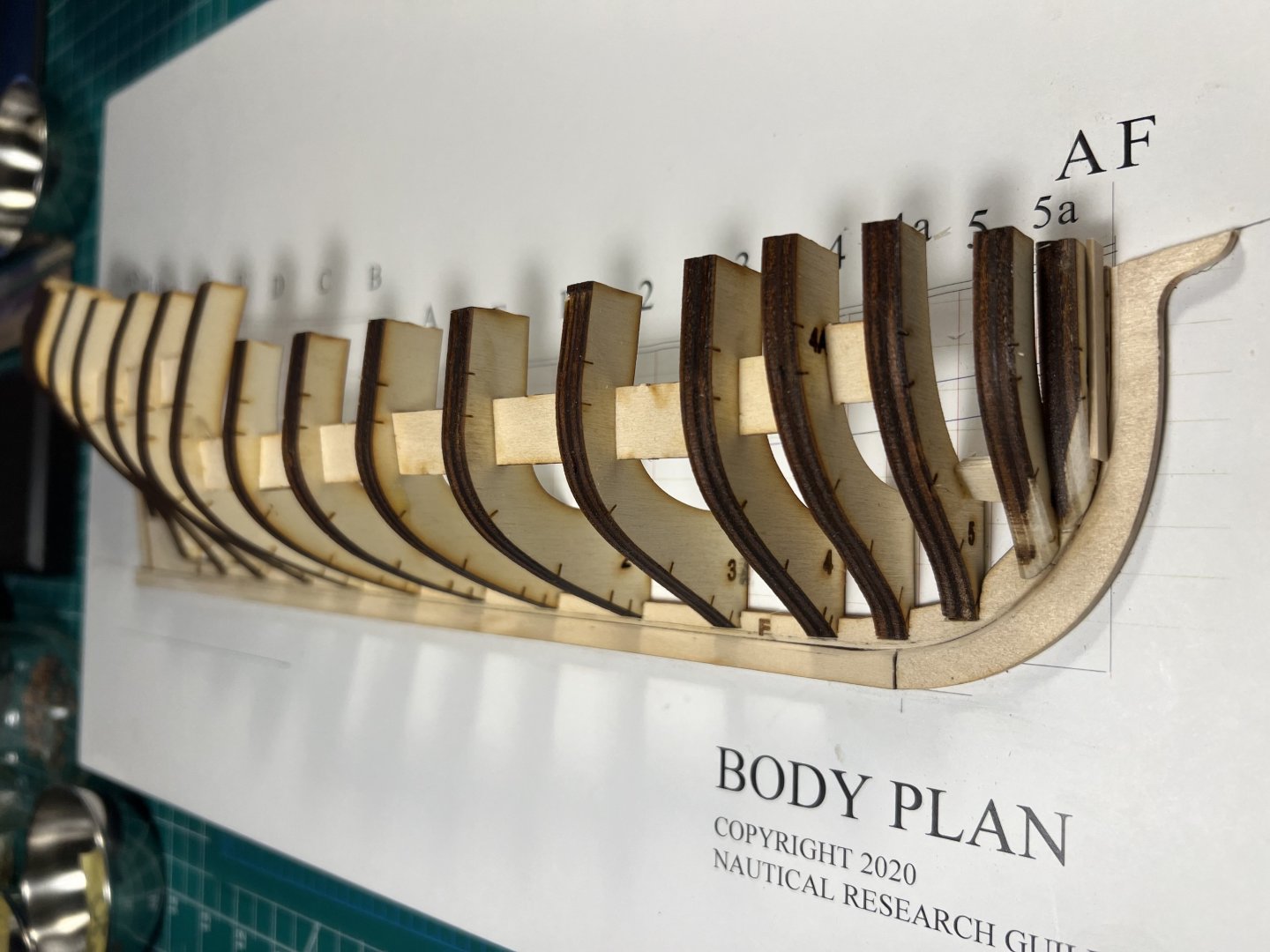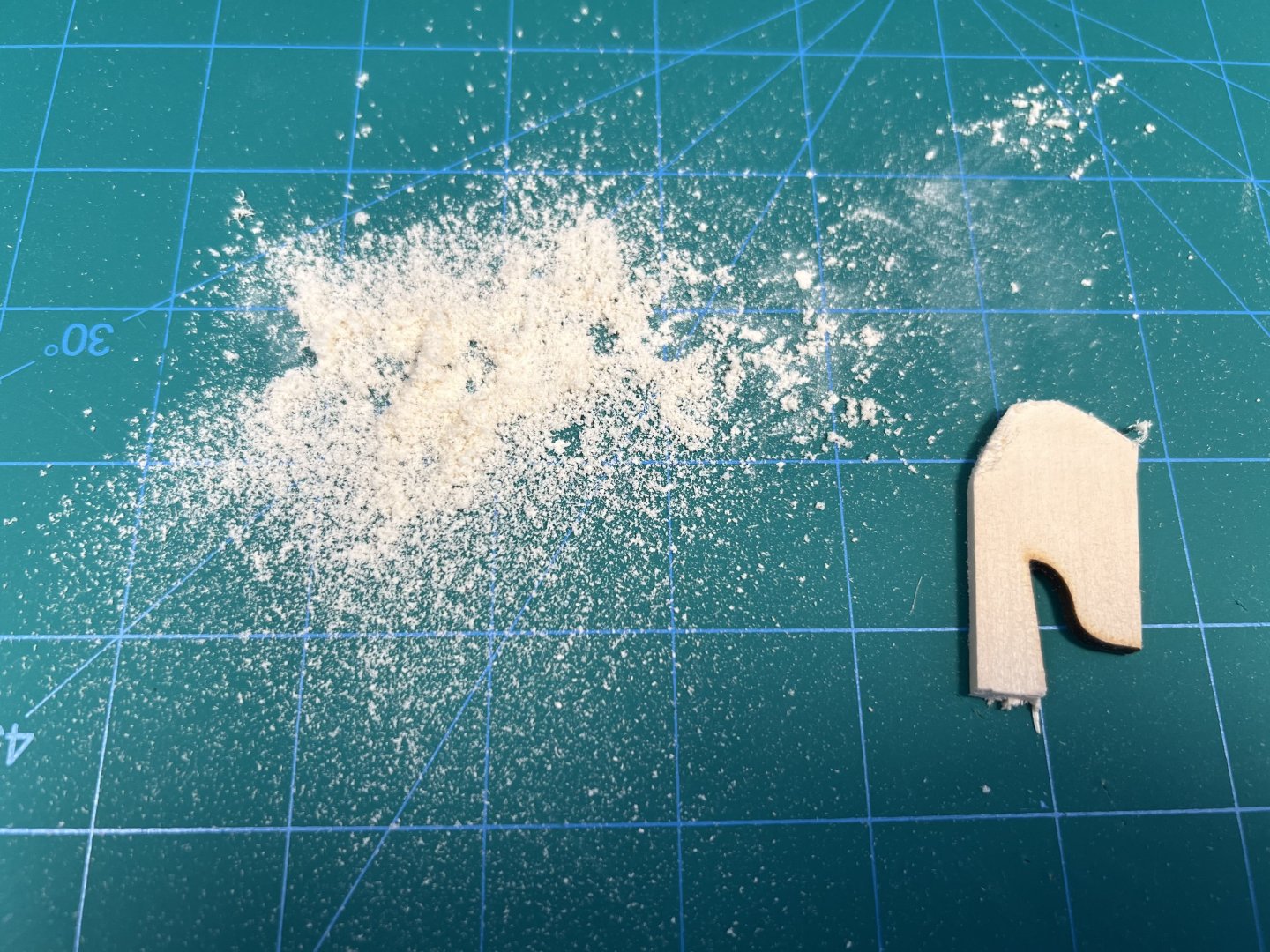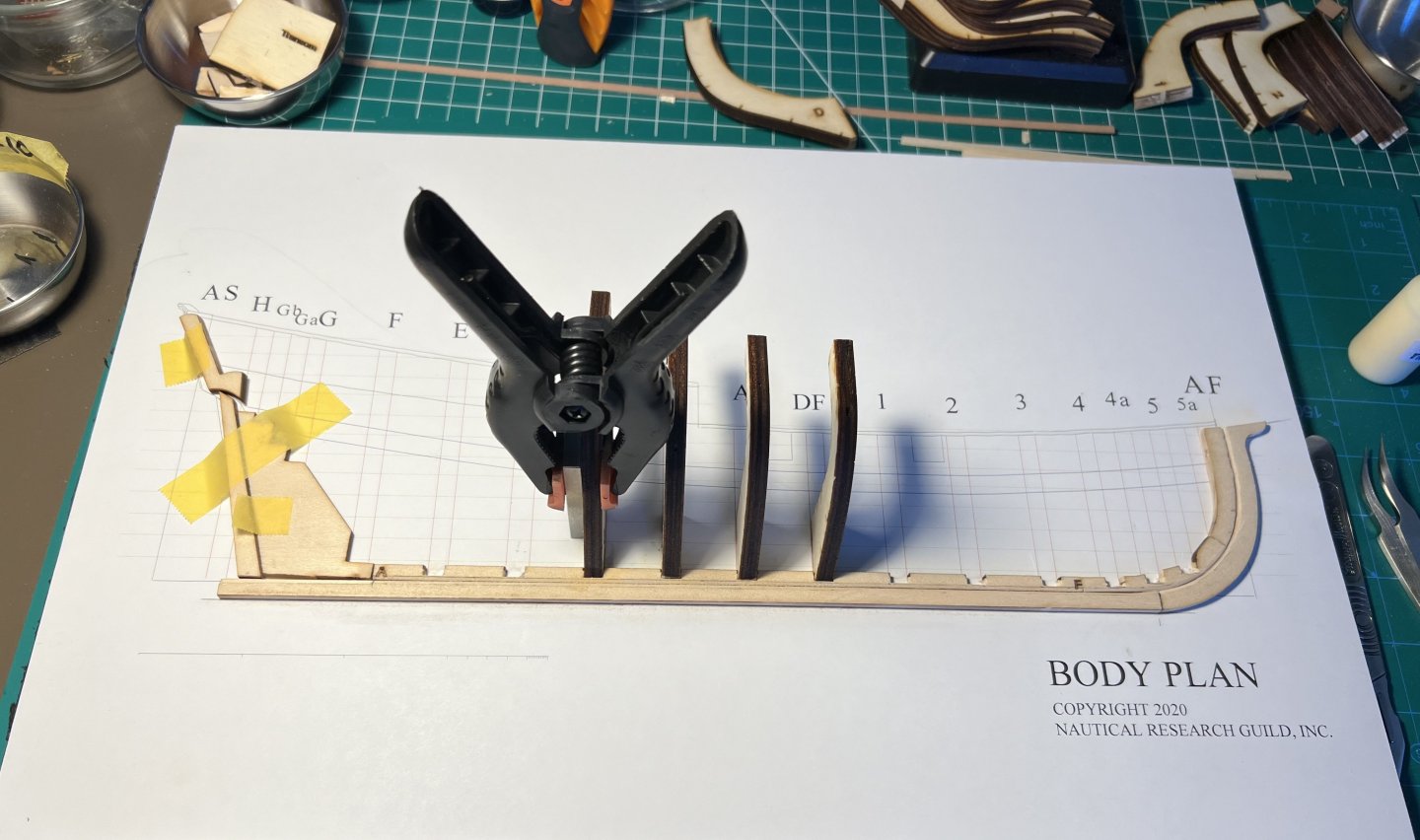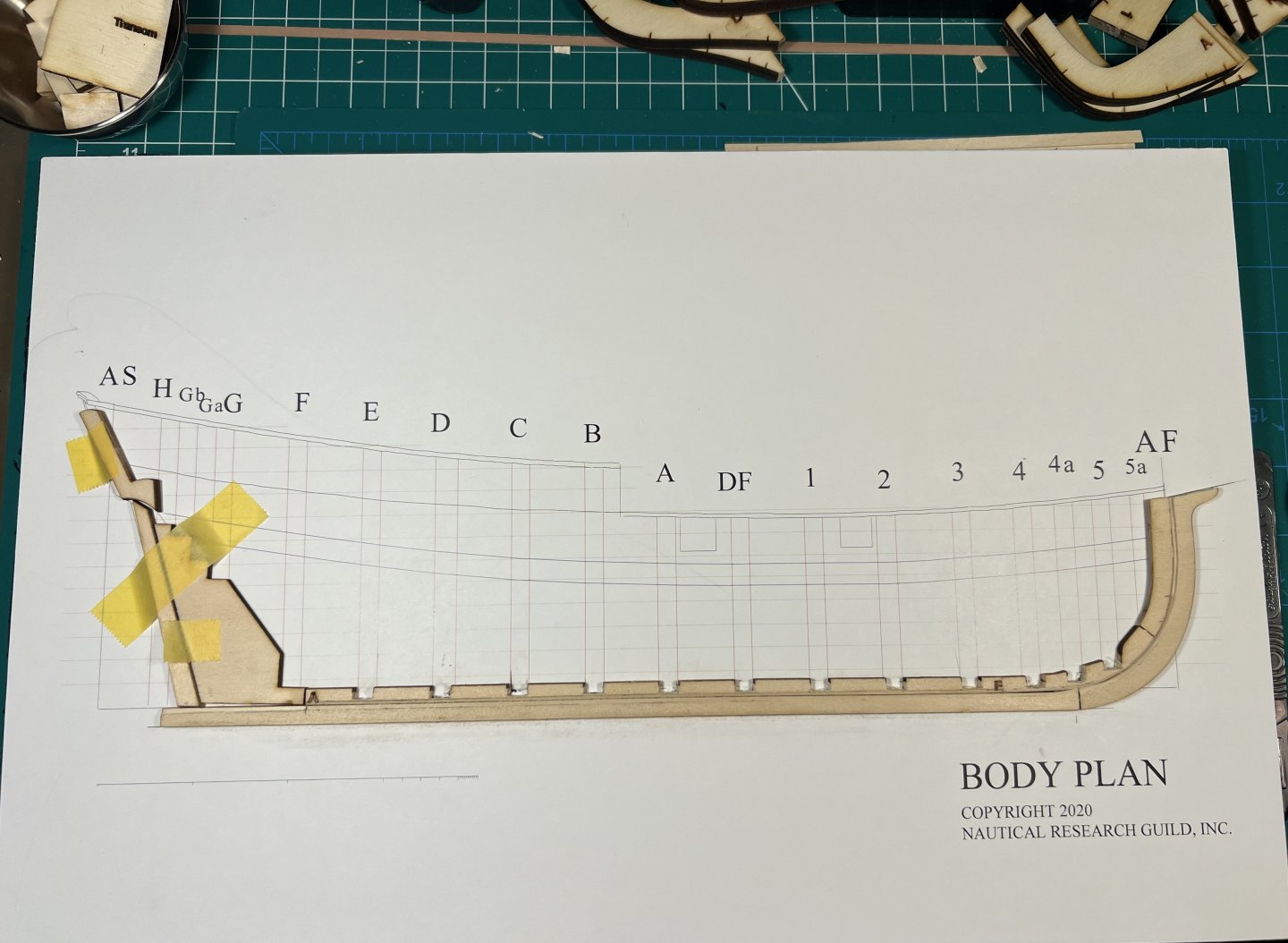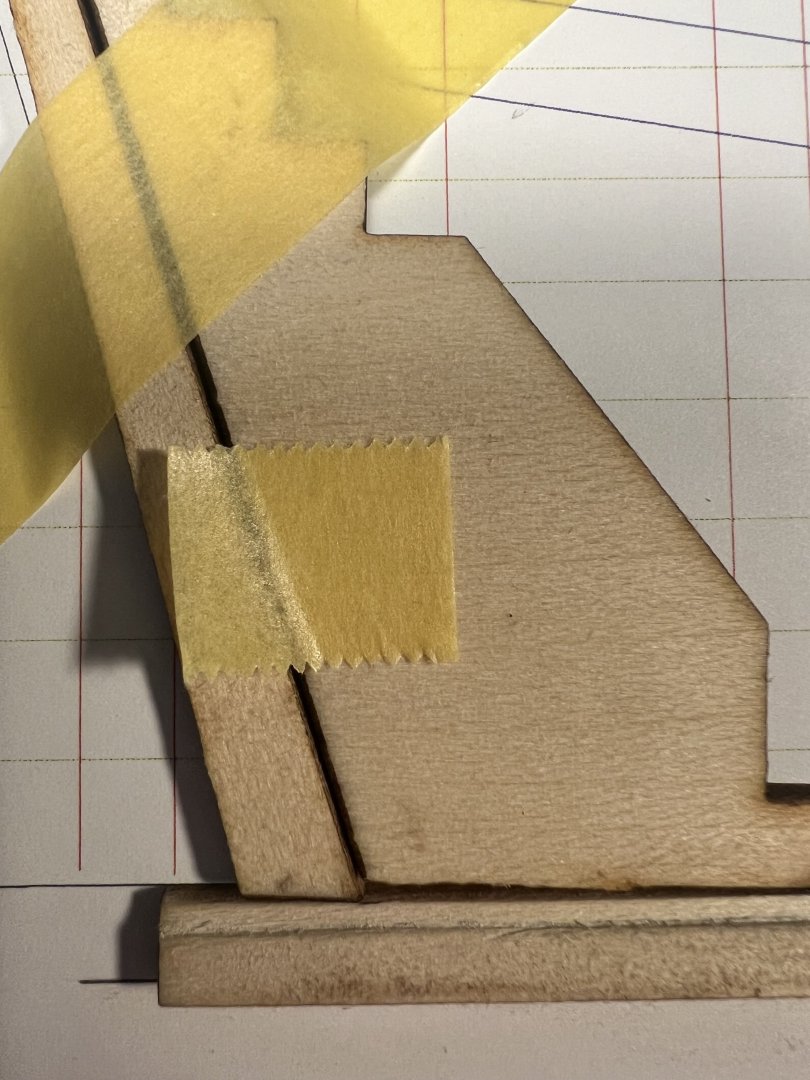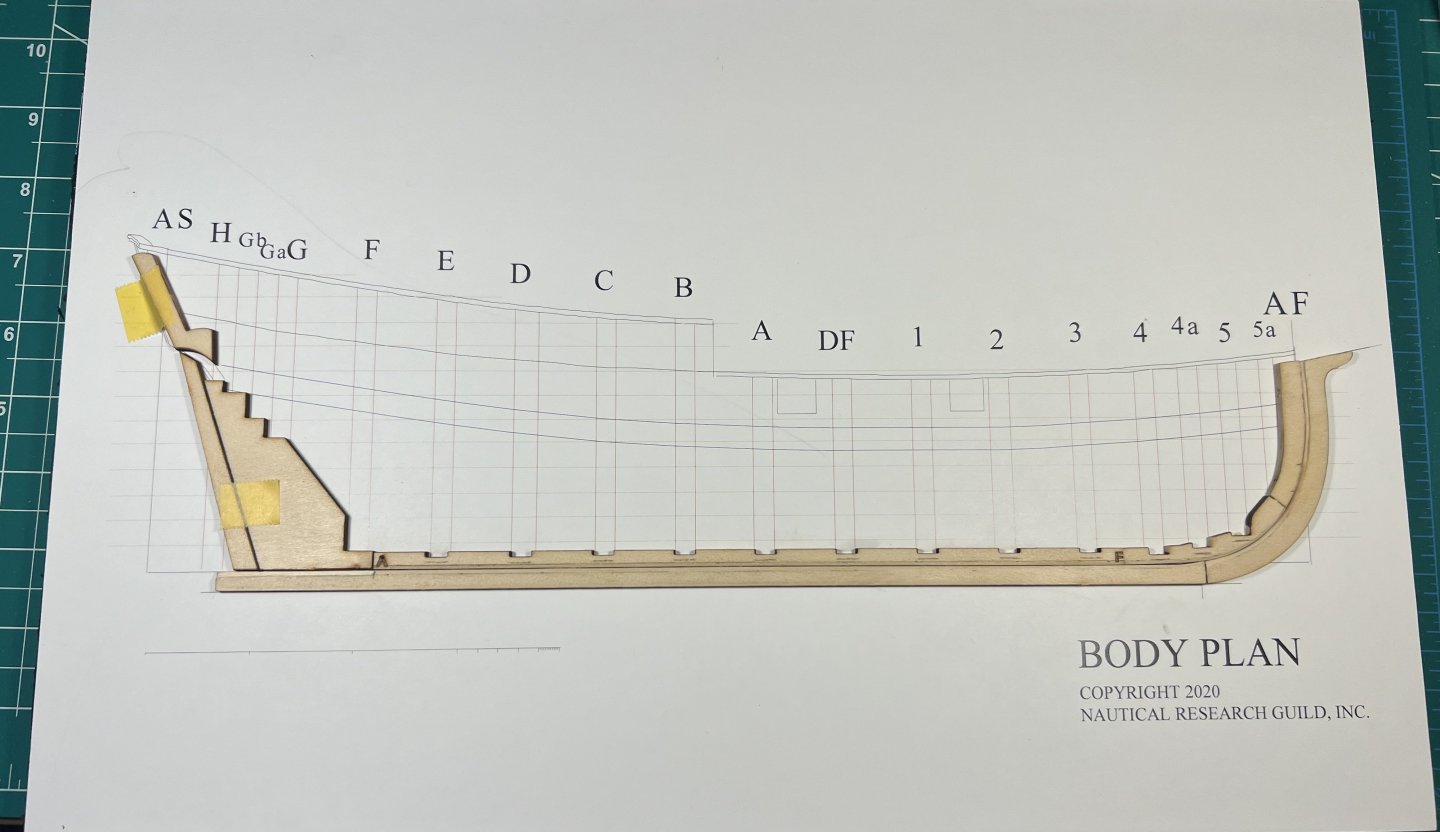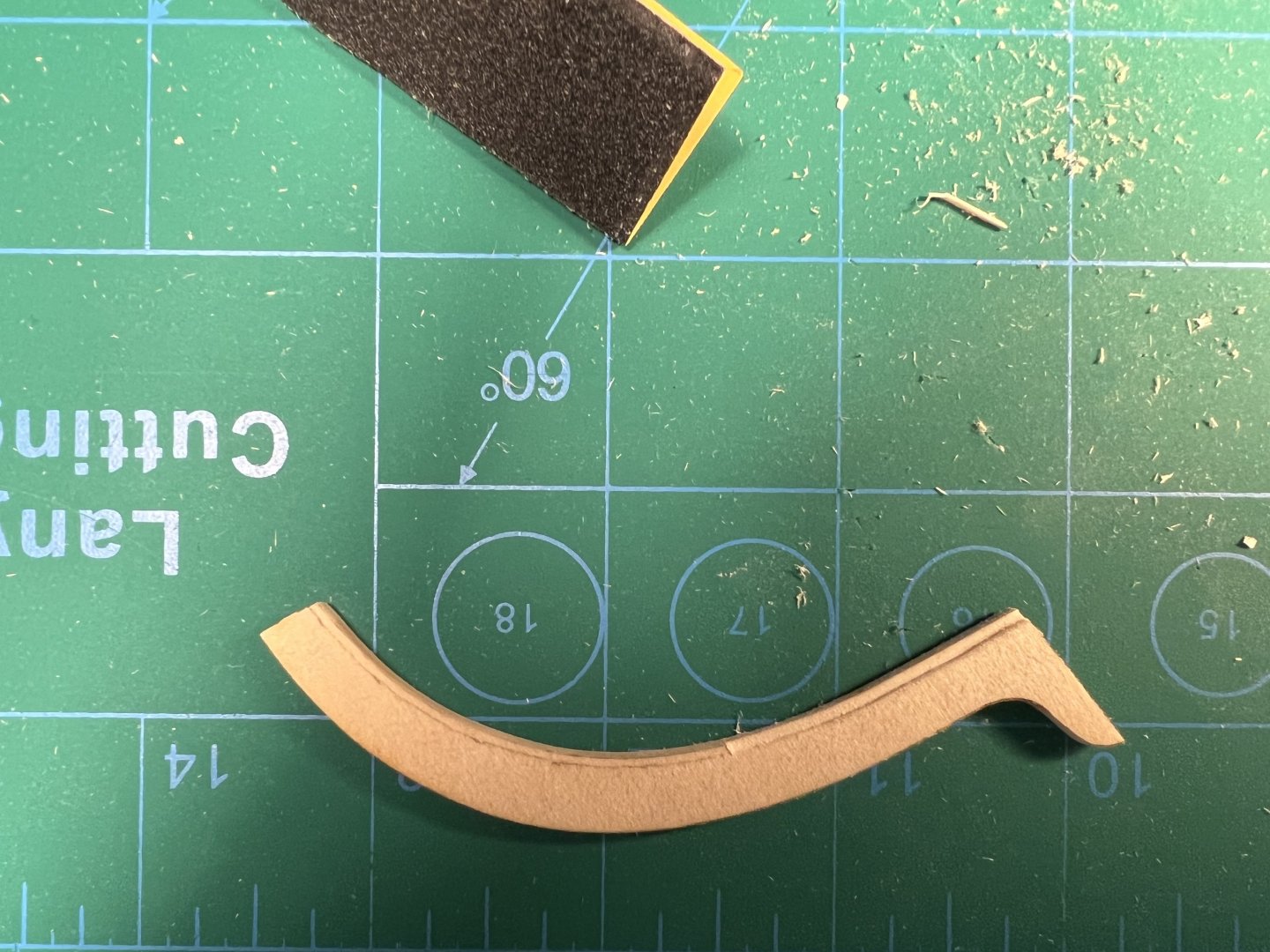
palmerit
NRG Member-
Posts
794 -
Joined
-
Last visited
Content Type
Profiles
Forums
Gallery
Events
Everything posted by palmerit
-
One part of the instructions that’s easy to miss (since it’s at the top of the next page) is that “the outer face of the counter has been sanded to mimic the curve on the L- shaped piece”. I wondered why the @tlevine build (screenshot) had “counter” sanded off quite a bit while some other builds did not.
- 81 replies
-
- half hull planking project
- NRG
-
(and 2 more)
Tagged with:
-
I wetted three strips of basswood. Clamping them wet and I’ll let them dry. Then I’ll glue down, let it dry, and fair again.
- 81 replies
-
- half hull planking project
- NRG
-
(and 2 more)
Tagged with:
-
Right. I realize now it was referring to the whole area where the counter lays against frame H. I thought it was the corner against the sternpost, which in fact you need to fair quite a bit - and I faired the “top” (relative to the build board) that I shouldn’t have touched.
- 81 replies
-
- half hull planking project
- NRG
-
(and 2 more)
Tagged with:
-
So here’s my plan. In the photo I’m holding two toothpicks (using them like arrows) The bottom one is pointing to where frame H intersects the stern post. I’m going to fair that down quite a bit after seeing how the planks lie in the @tlevine build (I’ve added a screen shot of a photo from her build). The top one is pointing to where the top of the counter intersects with frame H. You can see where I faired frame H too much. I’m going to use wood filler to build that up, let it dry, and then reshape. (Oh, and I haven’t yet glued in the counter - I’ve just laid it in place.)
- 81 replies
-
- half hull planking project
- NRG
-
(and 2 more)
Tagged with:
-
So I followed the (small) recommendation to hold off on adding the transom and counter until later in the build because they might snap off. I probably should have left them on because I faired frame H too much. I’m going to have to add some wood and filler to build it up again. The instructions also said not to sand the aft edge of frame H but I think I have to.
- 81 replies
-
- half hull planking project
- NRG
-
(and 2 more)
Tagged with:
-
Here are some zoomed in screen shots from later in the @tlevine build, showing how the wale will intersect with the counter, the shape of the counter, and how the counter and frame H intersect.
- 81 replies
-
- half hull planking project
- NRG
-
(and 2 more)
Tagged with:
-
The one part that’s a bit confusing is the placement, shaping, and fairing of the transom and counter. Part of that is because there are not a lot of photos of the stern of the hull. I’ve attached a few screen shots from some builds (so sorry I don’t cite the builders - I just did screen shots as I was reviewed several logs). The counter needs a fair amount of shaping to fit. The instructions note to leave an inset of 3/64” where the counter intersects with the transom because the counter will be planked. I’m going to assume the edge should be shaped to lay flat on the transom on one side and frame H on the other. I’m uncertain about whether to fair the transom with frames G-H. I’m going to assume so. I’m also uncertain how to shape H as in intersects the counter, except the note in the instructions to not sand the aft edge of frame H.
- 81 replies
-
- half hull planking project
- NRG
-
(and 2 more)
Tagged with:
-
Added the transom. It wasn’t clear to me how to orient it - I hope I did it right. I checked a bunch of logs and the way I did it matched a couple, but there weren’t a lot of photos to go by. The filler piece needed to be cut from scrap wood. I started with a manilla folder and cut a piece the right shape and then used that to trace out a piece I cut from the scrap wood. I used wood filler in some places to make an even flatter surface to lay the planking.
- 81 replies
-
- half hull planking project
- NRG
-
(and 2 more)
Tagged with:
-
Nearly done with the fairing. Need to fine tune a bit. Having thick frames meant more sanding but also meant I could really sand things down quite a bit.
- 81 replies
-
- half hull planking project
- NRG
-
(and 2 more)
Tagged with:
-
Yeah, I ended up switching to some 100/180 sanding sticks I have. They’re flexible, but not as flexible as a batton. Definitely more efficient.
- 81 replies
-
- half hull planking project
- NRG
-
(and 2 more)
Tagged with:
-
I’m trying to fair the hull with 220 grit sandpaper glued to a piece of pearwood from a sheet left over from my Sherbourne. It kind of acts like a batton and sanding stick at the same time. We’ll see how it goes. These frames are pretty thick, which is great for stability but makes for slow sanding. After using my dremel to even out the tops of the frames, I tried using it to start the fairing but I didn’t trust myself with it after it starting bouncing around.
- 81 replies
-
- half hull planking project
- NRG
-
(and 2 more)
Tagged with:
-
- 81 replies
-
- half hull planking project
- NRG
-
(and 2 more)
Tagged with:
-
- 81 replies
-
- half hull planking project
- NRG
-
(and 2 more)
Tagged with:
-
In addition to the Proxxon disc sander and a home-made jig, are there other recommended options to look for? I know the Byrnes disc sander is the best, but for now the company is not producing new machines, they just have accessories. Are there other good options? I see there's ones from Micro-Mark and Utlimation.
-
I'm looking for a recommendation on the next tool (possible power tool, or otherwise) I might find useful in my model ship building. I note at the end what I have now, which is a pretty good collection of the basic things I need (with some upgrades as noted), accumulated over the past few months. I'm wondering if there is something that would be worth an investment - making things easier, more precise, and quicker (I know that everything can be done by hand, but I also don't have a lot of free time, and tools are fun). One thing I've been frustrated with is not being able to maintain a flat edge and a 90 degree (or other) angle when having to narrow a piece of wood by cutting or sanding. For example, in doing the NRG half hull, there are spacers supplied (and in some cases you need to make spacers from scrap wood) to go between the frames to give the skeleton more rigidity. I needed to shave off a tiny bit of some of the spacers to they would fit (or had to add a shim to a spacer because it was too narrow and then had to shave the combo down). Sanding by hand definitely won't work. And even sanding along a sanding stick laying flat on the table, I still lose the flat side and 90 degree angle. And not having a 90 degree angle means the spacers are flat with the frames. I've thought about getting a small (micro) miter box. Some inexpensive ones only have spaces for a saw at 90, 45, and maybe 30 degrees. I'd rather get something with more flexibility (angles). I saw a more expensive one (Micro-Mark Dobson Miter-Rite) that's adjustable (various angles). I also saw the RP Toolz Cutter/Mitre Tool or Ultimation Slicer (guillotine style cutter). These can also cut on any angle, but with a guillotine rather than a razor saw. I don't know which style, miter with razor saw vs. guillotine/razor, is best for cutting wood (of varying thicknesses). (I know the guillotine style are useful for cutting copper for hulls, but that's not part of any model I have now.) And there are small micro (power) disc sanders that can sand at any angle. I saw a post about an Ultimation one. I know that there was a Byrnes one, but I don't know if they are still in business after the passing of Jim Byrnes (while accessories are still available, it seems the power tools are not). I imagine where are others. So I don't know if one of these (or multiple of these) might be useful. And if so, which? I had created a post earlier about possibly getting a micro lathe (with some responding that it was not needed, and others saying to wait to get something that can be upgrading to a milling machine). I think I'll wait on that to see if I get to doing more complex scratch building someday, where a lathe/milling machine might be more useful. After kitting yourself out with the basics (and upgrading some of the basics), what are the most useful tools (power or otherwise) to get? I'm pretty well equipped with the basics now, and even upgraded some things: - I have a Swann-Morton scalpel (with lots of 10A replacement blades) - they seem better than the cheap Xacto knife I started with. - I have a descent box cutter (with lots of razor blades that I replace often). - After starting with a cheap set of micro files that did not work well, I ended up upgrading to a set of Glardon-Vallorbe LA2442-0 Needle Files, which work much better. - After starting with what ended up being a (too small) small self-healing mat, I bought another 3'x4' one (with the small one on top of the larger one). Gives more working room. - I bought an Iwata eclipse HP-CS airbrush, which has worked great (it's one of the most highly-rated ones). I'm sure I could have done with a cheaper one, but this has worked great. - I bought a relatively inexpensive OPHIR Airbrush Spray Booth on amazon. I have the exhaust going into a large bucket (with filters, holes, and water in the bottom) because I don't have easy access to a window where I work (YouTube videos on how to kit this out). - I recently bought a Veritas mini block plane a set of Veritas mini chisels. I haven't had a need to use them just yet (I think I will soon). I ordered them and some tools for other projects from leevalley.com. - I have a Dremel and a bunch of accessories that I bought years ago - the only use so far has been an initial pass at fairing the hull (with the sander on the Dremel) on my Sherbourne. Afraid to get it near anything delicate (my clumsiness more than the Dremel). I don't know if there are useful Dremel add-ons I might find useful for model ship building. - I have a good selection of paint brushes (a few nice tiny Kolinsky red sable fine tip for fine painting) from an art supply store. - I have a cheap pin vise and bits that seems to work fine. I know that's something I could upgrade someday, but the one I have seems to work. - I have a descent, relatively inexpensive digital calipers, that I use fairly often (that switches between mm, fractional inches, decimal inches, which is nice). - I have some good Tamiya tweezers of a few varieties (after trying to use some cheap ones we had around the house that frustrated me). - I definitely see why Tamiya tape is the best. I have a bunch of widths for masking off sections (when spray painting and brush painting). - I obviously have a wide variety of sand paper and sanding sticks and see now the value of making your own sanding sticks (now that I have scrape wood from models to make them from). - I have a nice Tamiya side cutter (sprue cutter) that I bought because I've also been doing some plastic models. They're great and I've occasionally found use for them in model ship building too. - I have a good collection of clips of various sizes (and ended up buying some more after realizing I didn't have enough). Easy to find on Amazon and elsewhere. - I have the Model Shipways blank bender (built off a soldering iron I believe). It works well, and I've used it a bunch, but I've also burnt myself a few times - it gets very hot and the stand it comes with is garbage. I might try a travel iron approach sometime (not as hot, easier to use). - I have an inexpensive razor saw that's done its job when I've needed to use it.
-
Made a slurry of sawdust, glue, and water to fill the part of the mortice that shouldn’t be there. I’ll let it dry overnight and then sand. Might need to add some more sawdust if it isn’t smooth after sanding.
- 81 replies
-
- half hull planking project
- NRG
-
(and 2 more)
Tagged with:
-
- 81 replies
-
- half hull planking project
- NRG
-
(and 2 more)
Tagged with:
-
Next step was deepening the slots on the keelson using my scalpel and removing pieces with tweezers.
- 81 replies
-
- half hull planking project
- NRG
-
(and 2 more)
Tagged with:
-
I think I’m going to have to do some repair work. I don’t think the mortise is supposed to go past the start of the sternpost (and I got to that because I continued the rabbet too far). I’ll check the instructions, but if I’m right I’ll try filling in with sawdust and glue and sanding to fill that part in.
- 81 replies
-
- half hull planking project
- NRG
-
(and 2 more)
Tagged with:
-
- 81 replies
-
- half hull planking project
- NRG
-
(and 2 more)
Tagged with:
-
I think (?) I got the rabbets and mortises cut okay. I figure I can do a bit better at fine tuning if needed when the pieces are glued down and when I start to lay the planks. I did use the small piece of planking I cut to test fit in a bunch of places.
- 81 replies
-
- half hull planking project
- NRG
-
(and 2 more)
Tagged with:
-
- 81 replies
-
- half hull planking project
- NRG
-
(and 2 more)
Tagged with:
About us
Modelshipworld - Advancing Ship Modeling through Research
SSL Secured
Your security is important for us so this Website is SSL-Secured
NRG Mailing Address
Nautical Research Guild
237 South Lincoln Street
Westmont IL, 60559-1917
Model Ship World ® and the MSW logo are Registered Trademarks, and belong to the Nautical Research Guild (United States Patent and Trademark Office: No. 6,929,264 & No. 6,929,274, registered Dec. 20, 2022)
Helpful Links
About the NRG
If you enjoy building ship models that are historically accurate as well as beautiful, then The Nautical Research Guild (NRG) is just right for you.
The Guild is a non-profit educational organization whose mission is to “Advance Ship Modeling Through Research”. We provide support to our members in their efforts to raise the quality of their model ships.
The Nautical Research Guild has published our world-renowned quarterly magazine, The Nautical Research Journal, since 1955. The pages of the Journal are full of articles by accomplished ship modelers who show you how they create those exquisite details on their models, and by maritime historians who show you the correct details to build. The Journal is available in both print and digital editions. Go to the NRG web site (www.thenrg.org) to download a complimentary digital copy of the Journal. The NRG also publishes plan sets, books and compilations of back issues of the Journal and the former Ships in Scale and Model Ship Builder magazines.

